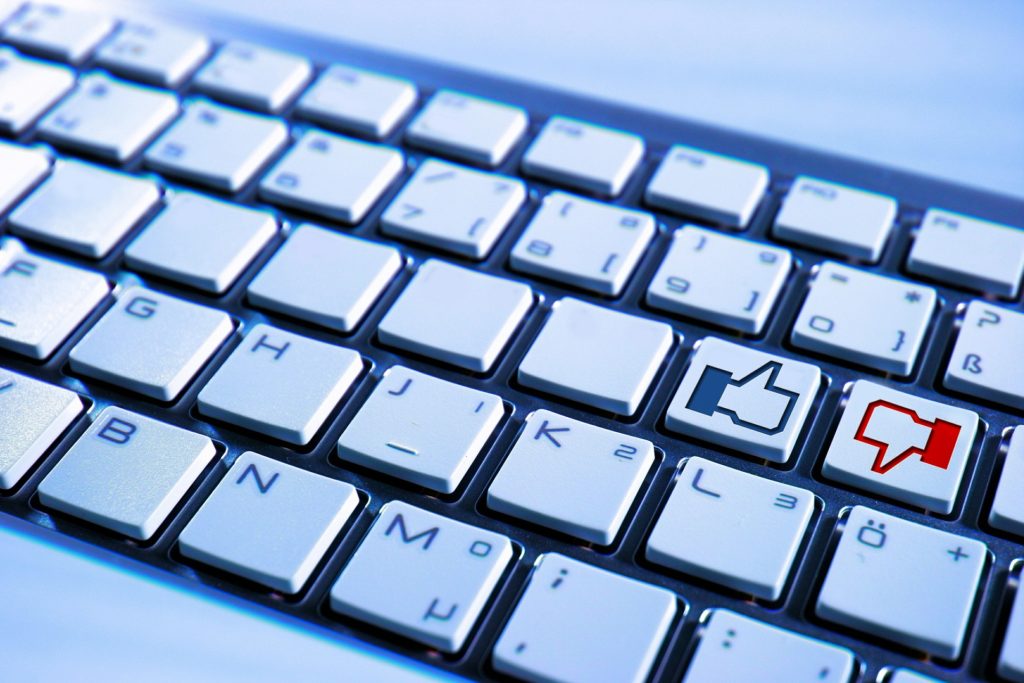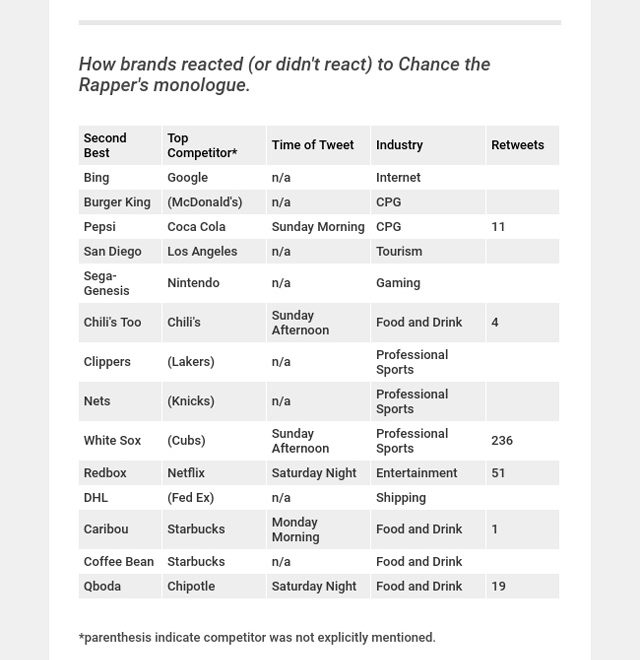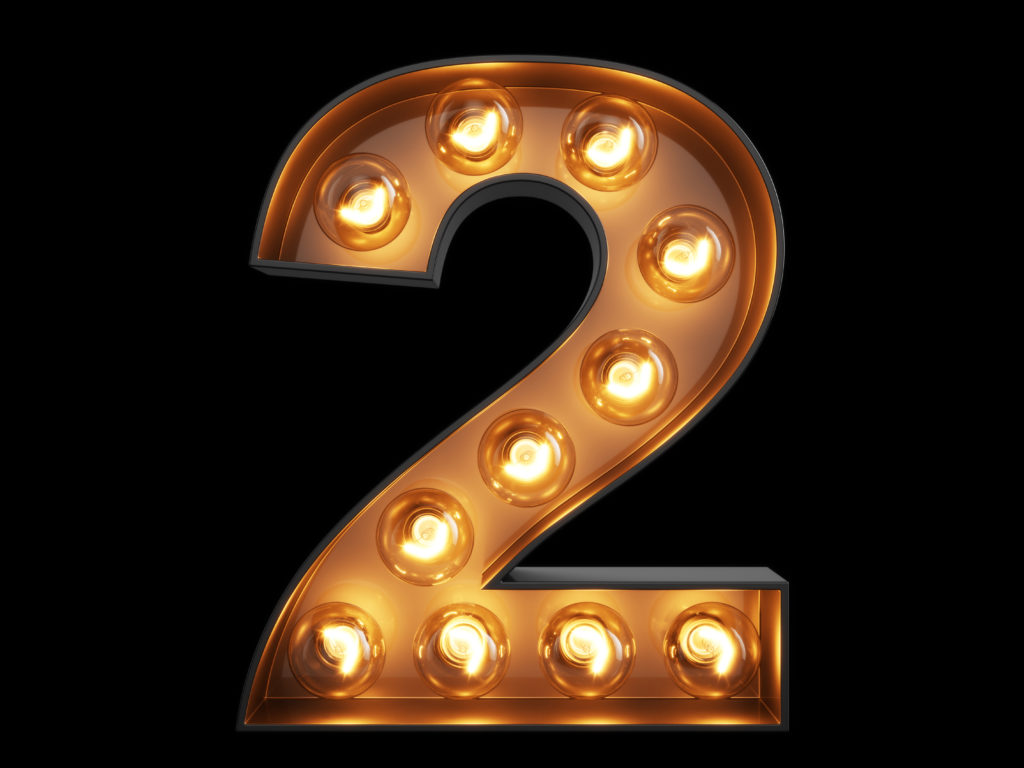
Whenever I talk to radio stations about their social media efforts, I often get mixed signals. Sometimes, programmers and managers freely admit their social activities leave a great deal to be desired. Inconsistency, too many admins, concerns about using the optimal platforms, and even what to post are common complaints.
Then there are the stations that tell me “We’re killing it on social media.” Oftentimes, their evaluations are based on empty metrics like “likes” and “followers,” rather than on engagement or community-building. But that doesn’t change opinions because social media proficiency is in the eye of the beholder.
Until now, that is.
A couple of weeks back, “Saturday Night Live” unleashed a real-time social media test. Like a pop quiz, no one saw it coming, so it made for a revealing look at how major brands respond to an unexpected opportunity.
Here’s what happened…
Chance the Rapper was the show’s celebrity guest. During his opening monologue/song, he acknowledged being a Chicago native – the ultimate “second city.” And from there, he broke into a brilliant rap ditty – giving shout-outs to a variety of brands that are perennial “#2’s” – like Pepsi, Burger King, and yes, the Chicago White Sox.
A marketer’s dream come true, right? Yes, but only if this free exposure on “SNL” is deftly amplified on social media, providing the opportunity to engage millions more consumers.
And that’s what got AdWeek opinion contributor Stephen Spiewak going – to determine which of these brands stepped up to answer the bell on Facebook, Twitter, Instagram, or other channels that Saturday night. As he notes, many brands mobilize their social media battalions around mega-events like the Super Bowl or the Oscar’s.
But here was just another episode of “SNL” – a not-so-special TV event. And of course, they gave no warning of what was to come. Radio has experienced similar challenges, albeit under more dire circumstances – weather emergencies, shootings, and other events that often strike at night, on weekends, and at times when few hands are on deck.
Chance the Rapper gave shout-outs to 14 brands during his rap song. And more than half were literally asleep at the switch. Here’s the social scorecard:

Only two brands – Redbox and Qdoba (excuse the spelling error) – actually “socialized” during the show. A few others got around to it on Sunday or even Monday. Interestingly, while the White Sox were late to the party, they garnered the most retweets, but as AdWeek noted, Chance was wearing their hat.
So, what can radio learn from this real-time exercise in social media mobilization?
Spiewak leaves us with two takeaways:
1. Timeliness matters – Brands have opportunities in the social space, but seizing the moment is still critically important. Most of the products and services that earned “second best” shout-outs derived little from a late response to Chance the Rapper’s gift horse.
2. Don’t focus on the competition – Spiewak makes the point that while these 14 runner-up brands reaped some nice mentions, most had to suffer through seeing and/or hearing their competitor mentioned – or at least hinted at. Chance throwing some love at these second best brands was a positive, if their respective marketing teams were smart enough to embrace the opportunity.
I’ll leave you with a few more:
3. Make a plan – Some may argue that a free plug at 11;35pm on a Saturday night in early November isn’t worth the bother. But when brands – including radio stations – have a system in place when something happens, at least there’s the option to respond in a timely and effective manner. You have to believe Bing, DHL and the Los Angeles Clippers had employees watching “SNL” who didn’t have a clue about who to call, text, or email to alert them to this opportunity. When there’s a go-to person and a system in place, a brand has the chance to engage at just the right time.
4. Know your social media voice – Many different admins may have access to your social media platforms, but over time, a radio station should have a distinct style, in much the same way your production does. Maybe it’s funny or snarky or edgy – whatever. That brand voice will dictate the tone in which you respond to the stimulus – whether it’s a moment like Chance provided or it’s the shocking passing of a station core artist or a famous local celebrity.
5. Use the right platforms – Believe it or not, many brands struggle with decisions about whether to emphasize a particular social site so they often spread their resources across multiple social networks. Most of the time, that’s an ineffective strategy. But most radio stations ought to know where their social media bread is buttered. Sorry to be a bit self-serving, but Techsurvey stakeholders know precisely how their fans line up by social media platform – where they have a profile and how often they engage. Of all the social media tests, this one’s the easiest to pass.
As we are learning – sometimes the hard way – there are hidden costs to social media – a loss of privacy and eroding organic reach, just for starters.
But despite its flaws, foibles, and failings, social media provides radio brands with a unique chance of connecting with its audience –  well beyond the “request lines” or hanging out at car dealer remotes.
well beyond the “request lines” or hanging out at car dealer remotes.
Social media provides unique opportunities – a megaphone for your brand that can go well beyond your cume, and even your metro. It’s a tool unlike radio has ever had before. When a station has a strategy and a well-managed social presence, good things can happen.
Even when you’re #2.
Any commercial radio station in North America can sign up for Techsurvey 2020 which field in January/February. Information and registration are available here.
And you may have noticed Adam Carolla is mentioned in Chance’s rap (second to Jimmy Kimmel), but is not listed in the AdWeek chart. I checked both his Twitter and Facebook pages – nada.
- What To Do If Your Radio Station Goes Through A Midlife Crisis - April 25, 2025
- A 2020 Lesson?It Could All Be Gone In A Flash - April 24, 2025
- How AI Can Give Radio Personalities More…PERSONALITY - April 23, 2025




A little late reading this one… but I would add a #6… “Your Actual Audio Content Matters” … Radio and Podcast companies are spending millions on their broadcasts or productions… and the content airs / or is released and then it falls off the proverbial cliff. I’m still astounded that in 2019 (and I follow dozens and dozens of platforms, stations and shows on social) … my social feed is missing… actual audio content!!! Highlights! Shareable… Searchable… Topical Content! Where is it? If you work on building a great radio show, and you believe that you are indeed broadcasting content that people enjoy listening to, or they are compelled by what you say… then don’t let it die after it hits the air! How do you use the content you create each day to give it legs? Do you let your audience discover and share those hot moments? Or, are you just waiting for them to tune in next time? If they’ve never heard your show, how do you expect them to sample it?
Every “X Big Radio Company” (not just one) station posts endless amounts of articles and blog content… NO AUDIO! “Kanye West is Running for President in 2024!” – is a headline found today… did the show talk about this morning? Where’s the highlight of listener calls and reactions?!?
I can’t tell you the last time I’ve seen a an audio highlight from a radio show in my social media feeds… why? There is always talk about podcasting having a discoverability problem… unfortunately, radio does too. Is it a problem… or a huge opportunity simply not being executed.
Test what I’m saying… if actually love to see a statistical analysis on this… do a study on social media posts by radio and or podcast entities, and see how much audio highlight content you see on social posts, and how many layers you have to go deep to find it. It won’t be pretty.
This is a twist on this… think about how easy it is to find a highlight or interview segment by Joe Rogan on YouTube or Social… he’s everywhere, and easy to find. His show puts out highlights daily. I’d love to meet his staff. Millions of views on his clips… sure, great guests, a big podcast audience… but he also has a big social and YouTube following as well… and it’s not by accident.
This is doable. And there is technology to help stations with this too… if you can’t seem to find a way to justify doing it in the first place… 😉
This is a very smart and astute content, Gil. So many stations focus on copy or video that their main product – audio – is forgotten. Ironic, eh? Appreciate you imparting this wisdom, and I hope some savvy radio people (or even podcasters) take it to heart.